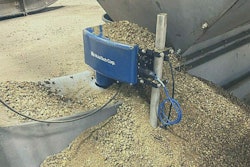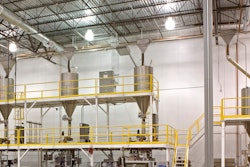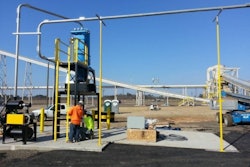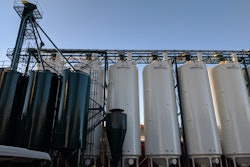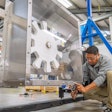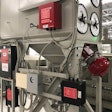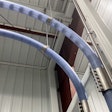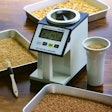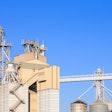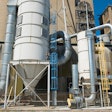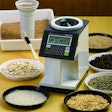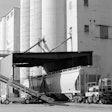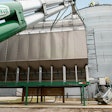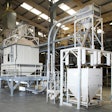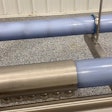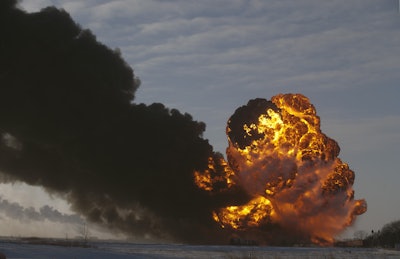
Food and agricultural facilities that process, handle and store grain and seed products generate high concentrations of dust that put employees and the plant in danger. Occupational exposure can trigger allergies and serious respiratory injury. Dusty floors can cause slipping accidents. Fire and explosion occur when dust particles that hang in the air or accumulate on surfaces come into contact with an ignition source.
This is why the Occupational Safety and Health Administration (OSHA) and National Fire Protection Association require facility operators to follow regulations designed to control dust in the workplace.
Installing a dust collection system is key to capturing airborne particles generated by routine processes like drying, shelling, grinding, conveying and storing feed and grain products. Ideally, the system should be specifically designed for your facility by a dust collection expert who is knowledgeable about applicable regulations and who can recommend the right number of collectors, configuration, venting and safety equipment for your applications and dust types.
Regulatory Watchdogs
OSHA requires facilities to control dust emissions in indoor workplaces and to comply with legal limits set for each ingredient and material. If there isn’t an applicable legal limit, facility operators are required to create and implement their own environmental safety plan.
The NFPA recommends standards and guidelines for managing combustible dusts. If manufacturers do not follow these guidelines, OSHA can fine them or bring legal action.
Important regulations for agricultural and food processing facilities include:
OSHA1910– general standard applicable to most industries
OSHA1928– for agriculture
OSHA1910.272– for grain handling facilities
NFPA652– general standard on combustible dust
NFPA61– covers fires and dust explosions in agricultural and food processing facilities
If the facility’s food and grains are for human consumption, the FDA’sFood Safety Modernization Actrequires operators to implement measures to minimize or prevent cross-contamination hazards. This includes collecting and removing all contaminants, including dust particles, before they become airborne.
Medical Dangers to Employees
Regular inhalation of fine dust particles causes serious respiratory problems because they are easily inhaled and penetrate deep into the lungs. This can lead to life-threatening conditions such as occupational asthma and lung cancer. In particular, exposure to food and grain dust can lead to these conditions, as well as farmer’s lung and organic dust toxic syndrome. Less critical dust-related ailments include skin and sinus allergies.
Fire and Explosion Hazards
In the first half of 2020, dust generated in food processing operations were responsible for 41 fires, 8 explosions and 11 injuries globally, according to the2020年中可燃粉尘事故报告. That’s 40.8% of all recorded incidents. Since 2017, agricultural activity and food production were the cause of 33% to 45% of annual overall fire and explosion incidents. The highest percentage of combustible dust incidents overall in the first half of 2020 originated in storage silos, totaling 22 fires and 6 explosions.
Ignition sources that can cause feed and grain dust to catch fire or explode include:
- Overheated motors, gears and bearings
- Malfunctioning conveyer belts
- Spark-generating welding, cutting and brazing
- Power surges
- Restarting production equipment after shutdown or process upset
Controlling Food & Grain Dusts
An industrial dust collection system with high-efficiency primary and secondary cartridge-style filters reduces hazardous dust exposure and explosion risk. When properly designed, installed and maintained, these systems help facility operators keep workers and plants safe and meet regulatory requirements.
TheGold Series X-Flodust collector is ideal for agricultural and food facilities because it collects fine, fibrous and heavy dust loads at their source to prevent worker exposure to airborne contaminants and to keep dust from travelling throughout the facility. The GSX system also helps food and agricultural facilities exceed OSHA indoor air quality standards. When equipped with a Camfil explosion vent, the GSX system offers the highest combustible dust explosion protection in accordance with NFPA standards. Other explosion protection options are available including isolation valves, integrated safety monitoring filters and fire-retardant filter cartridges.
Selecting the right filter cartridges and filter media are key to effectively capturing dust. Consult a dust collection expert to help you choose primary filter media that is best suited for the particle size, flow characteristics, quantity and distribution of your process dust. If you don’t use a HEPA filter in the primary filtration system, it is best to install a secondary HEPA filter downstream to ensure hazardous dusts are not discharged into the atmosphere.
The construction of the filter is important, too. Look for a wide, uniformly pleated filters because they better release the the collected dust to release from the filter. This improves performance because it keeps the resistance lower through the filter for a longer time. Filter media with tightly packed pleats won’t let the reverse-pulse cleaning system of the dust collector eject much of the dust that has settled in between the pleats. Tightly packed pleats also increase the resistance of the air through the filters and diminish airflow, which compromises performance.
Gold Cone™ X-Flo filter cartridges(GCX) contain more pleated media to move more air and process more dust, creating a more uniform airflow through the collector. The GCX filter cartridges feature specially designed inner cones with more downward-facing media than traditional filters. This extends the life of the filters and uses less compressed air. They are available with filtration efficiencies up to MERV 16 per ASHRAE 52.2:2017 to provide the best protection from harmful airborne contaminants.
For assistance selecting the best dust collector or filter cartridges for your specific feed and grain processes,contact a Camfil dust collection expert.





